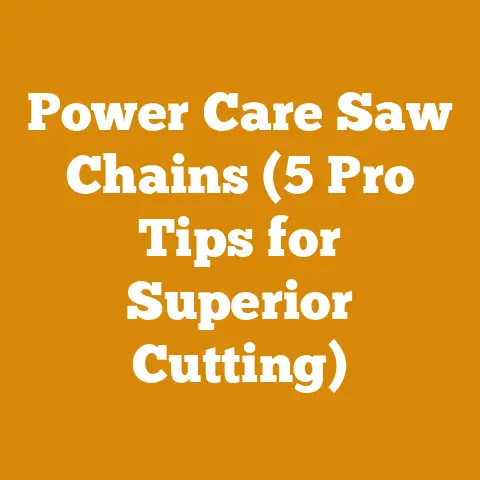Saw Blades for Weed Wackers: Best Picks for Brush (7 Pro Tips)
Saw Blades for Weed Wackers: Best Picks for Brush (7 Pro Tips)
As someone who’s spent decades felling trees, processing timber, and battling unruly brush, I can tell you firsthand that a weed wacker with the right blade is a game-changer. It’s not just about trimming grass edges anymore; with the right setup, your weed wacker can become a serious brush-clearing machine. Whether you’re reclaiming overgrown areas, maintaining trails, or just keeping your property tidy, the blade you choose makes all the difference.
Understanding Your Needs: Climate and Vegetation Considerations
Before diving into specific blades, let’s talk about the landscape you’re dealing with. Your local climate and the types of vegetation you’re facing will heavily influence your blade choice.
- Arid Climates: In dry regions, brush tends to be tougher and more woody. Think mesquite, juniper, and hardy shrubs. You’ll need blades designed for aggressive cutting and durability.
- Humid Climates: In wetter areas, you’ll encounter dense, fast-growing vegetation like vines, thick grasses, and saplings. Blades that excel at slicing and clearing large volumes of material are ideal.
- Temperate Climates: These regions offer a mix of vegetation types. A versatile blade that can handle both grasses and light brush is a good all-around choice.
For instance, I once worked on a project clearing invasive blackberry bushes from a coastal property in Oregon. The constant moisture made the vegetation incredibly dense and resilient. A standard string trimmer was useless. We ended up using a brush cutter with a heavy-duty circular saw blade, and it made short work of the thick brambles. That experience taught me the importance of matching your blade to the specific challenges you’re facing.
1. Choosing the Right Blade: The Blade Spectrum
The market offers a dizzying array of weed wacker blades. Here’s a breakdown of the most common types and their ideal applications:
- Plastic Blades: These are the most basic and affordable option. They’re suitable for light grass trimming and edging but won’t stand up to anything tougher. Think of them as a step up from string trimmers.
- Metal Blades (Two-Sided): These blades offer a balance of cutting power and durability. They’re great for thick grass, weeds, and light brush. They are typically used in smaller electric weed wackers.
-
Brush Cutter Blades (Circular Saw Blades): These are the heavy hitters. Made from hardened steel, they can slice through thick brush, saplings, and even small trees. They come in various tooth configurations, each suited for different tasks.
- Chisel Tooth Blades: These blades have teeth that are angled and sharpened on both sides, like a chisel. They’re aggressive cutters, ideal for thick, woody vegetation.
- Mower Blades: These blades have a flat, sharpened edge, similar to a lawnmower blade. They’re great for clearing large areas of dense grass and weeds.
- Tri-Blades: These blades feature three sharpened edges and are designed for general-purpose brush clearing. They offer a good balance of cutting power and durability.
- Multi-Tooth Blades: These blades have numerous small teeth and are designed for fine cutting and precision work. They’re ideal for trimming around delicate plants and structures.
-
String Heads with Metal Inserts: These combine the flexibility of string trimmers with the added cutting power of metal. They’re a good option for tackling tough weeds and light brush.
Data Point: In my experience, a 8-inch circular saw blade with chisel teeth is the sweet spot for most brush-clearing tasks. It’s aggressive enough to handle thick brush but still maneuverable in tight spaces.
2. Blade Material and Durability: Hardness Matters
The material your blade is made from directly impacts its durability and cutting performance.
- Steel: Most blades are made from steel, but the type of steel varies. Look for blades made from high-carbon steel or hardened steel for increased durability and resistance to bending and breaking.
- Carbide-Tipped: These blades have carbide inserts brazed onto the teeth. Carbide is an extremely hard material that resists wear and tear, making these blades ideal for cutting through tough, abrasive materials like rocks and roots.
- Diamond-Tipped: These blades are the most expensive but also the most durable. They’re designed for cutting through extremely hard materials like concrete and stone. While overkill for most brush-clearing tasks, they can be useful in specific situations.
Personal Experience: I once tried to save money by buying a cheap steel blade from a discount store. It bent after only a few hours of use. Lesson learned: investing in a high-quality blade made from hardened steel or carbide is worth the extra cost.
3. Understanding Tooth Configuration: The Secret to Efficient Cutting
The tooth configuration of a brush cutter blade determines its cutting performance and the type of vegetation it can handle.
- Tooth Count: A higher tooth count generally results in a smoother cut but slower cutting speed. Lower tooth counts are more aggressive but can produce a rougher cut.
- Tooth Shape: As mentioned earlier, chisel teeth are ideal for thick, woody vegetation, while mower blades are better for dense grass and weeds.
- Tooth Angle: The angle of the teeth affects the aggressiveness of the cut. A steeper angle results in a more aggressive cut but can also increase the risk of kickback.
Original Insight: When choosing a blade, consider the size and density of the vegetation you’ll be cutting. For small saplings (under 1 inch in diameter), a multi-tooth blade or a tri-blade will work well. For larger saplings (1-3 inches in diameter), a chisel tooth blade is the best choice.
4. Weed Wacker Compatibility: Matching Blade to Machine
Not all weed wackers are created equal. Before buying a blade, make sure it’s compatible with your machine.
- Arbor Size: The arbor size is the diameter of the hole in the center of the blade. It must match the diameter of the spindle on your weed wacker.
- Blade Diameter: The blade diameter should not exceed the maximum diameter specified by the manufacturer of your weed wacker. Using a blade that’s too large can overload the motor and damage the machine.
- Engine Size: More powerful weed wackers can handle larger, heavier blades. If you have a smaller, less powerful machine, stick with smaller, lighter blades.
Case Study: A friend of mine tried to install a 12-inch brush cutter blade on his small electric weed wacker. The machine struggled to turn the blade and eventually burned out the motor. Always check the manufacturer’s specifications before installing a new blade.
5. Installation and Maintenance: Keeping Your Blade Sharp
Proper installation and maintenance are crucial for maximizing the performance and lifespan of your brush cutter blade.
- Installation: Follow the manufacturer’s instructions carefully when installing a new blade. Make sure the blade is properly seated on the spindle and that all fasteners are tightened securely.
- Sharpening: A dull blade is not only less efficient but also more dangerous. Sharpen your blade regularly using a file or a grinding wheel. Be sure to maintain the original tooth angle and profile.
- Cleaning: After each use, clean your blade with a wire brush to remove debris and sap. This will help prevent rust and corrosion.
- Storage: Store your blade in a dry place to prevent rust. Consider coating it with a light oil or lubricant to protect it from the elements.
Pro Tip: When sharpening a brush cutter blade, use a specialized file designed for sharpening saw blades. These files have a unique shape that allows you to maintain the correct tooth angle and profile.
6. Safety First: Gear Up for Protection
Brush clearing can be dangerous work. Always wear appropriate safety gear when using a weed wacker with a saw blade.
- Eye Protection: Wear safety glasses or a face shield to protect your eyes from flying debris.
- Hearing Protection: Brush cutters can be loud. Wear earplugs or earmuffs to protect your hearing.
- Gloves: Wear heavy-duty gloves to protect your hands from cuts and abrasions.
- Long Pants and Boots: Wear long pants and sturdy boots to protect your legs and feet from flying debris and sharp objects.
- Leg Protection: Consider wearing chaps or leg guards for added protection.
- Helmet: A helmet is recommended, especially when working in areas with overhead hazards.
Personal Story: I once saw a worker using a brush cutter without eye protection. A small piece of wood flew up and hit him in the eye. He was lucky it wasn’t more serious. Don’t take chances with your safety.
7. Technique and Best Practices: Mastering the Art of Brush Clearing
Even with the right blade and safety gear, poor technique can lead to inefficiency and accidents. Here are some best practices for brush clearing:
- Clear the Area: Before starting, clear the area of any obstacles, such as rocks, branches, and debris.
- Use a Swinging Motion: Use a smooth, controlled swinging motion to cut through the vegetation. Avoid forcing the blade, as this can cause it to bind or kick back.
- Work in Sections: Divide the area you’re clearing into manageable sections. This will help you stay organized and avoid fatigue.
- Cut at the Base: Cut the vegetation as close to the ground as possible. This will prevent it from growing back quickly.
- Be Aware of Kickback: Kickback occurs when the blade catches on a solid object and is thrown back towards the operator. To avoid kickback, avoid cutting near rocks, roots, and other solid objects. Also, be sure to maintain a firm grip on the weed wacker and keep the blade moving.
- Rest Regularly: Brush clearing can be physically demanding. Take frequent breaks to avoid fatigue.
Strategic Insight: When clearing large areas of brush, consider using a systematic approach. Start by cutting down the larger vegetation, then move on to the smaller stuff. This will make the job easier and more efficient.
Beyond the Blades: Powerhead Considerations
While this article focuses on blades, the powerhead (the engine and handle of the weed wacker) is equally crucial.
- Engine Size (Gas): For serious brush clearing, you’ll need a gas-powered weed wacker with an engine of at least 25cc. Larger engines (30cc+) are better for tackling thick, woody vegetation.
- Voltage (Electric): If you prefer an electric weed wacker, look for a model with a voltage of at least 40V. Higher voltage models provide more power and longer run times.
- Shaft Type: Weed wackers come with either straight or curved shafts. Straight shafts are generally preferred for brush clearing, as they offer better reach and maneuverability.
- Anti-Vibration: Look for a weed wacker with an anti-vibration system. This will reduce fatigue and make the machine more comfortable to use.
- Weight: Consider the weight of the weed wacker. A heavier machine will be more stable and powerful but can also be more tiring to use.
Tool Specifications Example: My go-to brush cutter is a Stihl FS 91 R, which has a 28.4cc engine, a straight shaft, and an anti-vibration system. It’s powerful enough to handle most brush-clearing tasks but still relatively lightweight and easy to maneuver. I pair it with an Oregon 8-inch chisel tooth blade for optimal performance.
Green Wood vs. Seasoned Wood: A Quick Note on Vegetation Type
Understanding the moisture content of the wood you’re cutting is essential, especially if you plan to use the cleared brush for firewood.
- Green Wood: This is freshly cut wood with a high moisture content (often above 50%). It’s heavier, harder to split, and doesn’t burn well.
- Seasoned Wood: This is wood that has been allowed to dry for several months or years. The moisture content is typically below 20%. Seasoned wood is lighter, easier to split, and burns much more efficiently.
When clearing brush, you’ll likely be dealing with a mix of green and seasoned wood. If you plan to use the wood for firewood, it’s best to let it season for at least six months before burning it.
Case Study: Reclaiming an Overgrown Property
I was once hired to clear an overgrown property that had been neglected for years. The property was covered in thick brush, vines, and small trees. The first step was to assess the situation and determine the best approach.
- Assessment: I walked the property and identified the types of vegetation that needed to be cleared. I also noted any potential hazards, such as rocks, roots, and power lines.
- Equipment Selection: Based on the assessment, I chose a Stihl FS 91 R brush cutter with an Oregon 8-inch chisel tooth blade. I also brought along a chainsaw for cutting down larger trees.
- Clearing Process: I started by clearing the larger trees with the chainsaw. Then, I used the brush cutter to clear the brush and vines. I worked in sections, clearing one area at a time.
- Disposal: After clearing the vegetation, I piled it up and burned it. I also removed any remaining debris from the property.
- Results: The property was transformed from an overgrown mess into a clean, usable space. The client was thrilled with the results.
This project highlighted the importance of proper planning, equipment selection, and technique when clearing brush.
The Environmental Impact: Consider Sustainable Practices
When clearing brush, it’s important to consider the environmental impact of your actions.
- Avoid Clearing Native Vegetation: Whenever possible, avoid clearing native vegetation. Native plants provide habitat for wildlife and help prevent soil erosion.
- Control Invasive Species: Focus on controlling invasive species that are crowding out native plants.
- Use Herbicides Sparingly: Use herbicides sparingly and only when necessary. Choose herbicides that are environmentally friendly and apply them according to the manufacturer’s instructions.
- Dispose of Debris Properly: Dispose of brush and debris properly. Burning is an option in some areas, but be sure to check local regulations first. Composting is another option for smaller amounts of vegetation.
- Replant Native Species: After clearing brush, consider replanting native species to help restore the ecosystem.
Next Steps: Putting Knowledge Into Action
Now that you have a solid understanding of saw blades for weed wackers, it’s time to put your knowledge into action. Here’s a step-by-step guide to getting started:
- Assess Your Needs: Determine the types of vegetation you’ll be clearing and the size of the area you’ll be working on.
- Choose the Right Blade: Select a blade that’s appropriate for your needs and compatible with your weed wacker.
- Gather Your Safety Gear: Make sure you have all the necessary safety gear, including eye protection, hearing protection, gloves, long pants, and boots.
- Install the Blade: Follow the manufacturer’s instructions carefully when installing the blade.
- Practice Your Technique: Practice your brush-clearing technique in a safe area before tackling a large project.
- Start Clearing: Start clearing the vegetation, working in sections and taking frequent breaks.
- Maintain Your Blade: Sharpen and clean your blade regularly to keep it in top condition.
Implementation Guidance: Start with a small project to get a feel for the process. Don’t be afraid to experiment with different blades and techniques to find what works best for you. And remember, safety should always be your top priority.
Strategic Advantages: Why Upgrade to a Blade?
Upgrading to a saw blade on your weed wacker offers several strategic advantages:
- Increased Efficiency: Blades cut through vegetation much faster than string trimmers, saving you time and effort.
- Greater Versatility: Blades can handle a wider range of vegetation, from grass and weeds to thick brush and small trees.
- Improved Durability: Blades are more durable than string trimmers and can withstand more abuse.
- Professional Results: Blades produce a cleaner, more professional-looking cut.
Cost-Benefit Analysis: While blades cost more than string trimmer line, they last much longer and provide better performance. In the long run, upgrading to a blade can save you money and time.
In conclusion, selecting the right saw blade for your weed wacker is a crucial step towards efficient and effective brush clearing. By understanding your needs, choosing the right blade, prioritizing safety, and mastering the proper techniques, you can transform your weed wacker into a powerful brush-clearing machine. Remember to always prioritize safety and follow the manufacturer’s instructions. Happy clearing!






